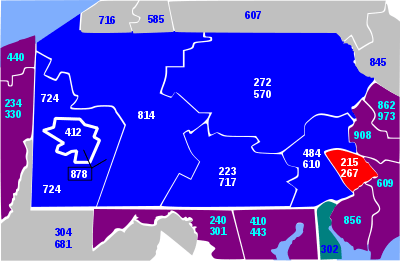Area codes 215, 267, and 445

Area codes 215, 267, and 445 are the North American telephone area codes for the City of Philadelphia, as well as its suburbs in Bucks and Montgomery Counties in the Commonwealth of Pennsylvania. 215 is the main area code, while 267 and 445 are overlay codes covering the same area as 215.
Area code 215 was one of the original area codes established in 1947 and originally included the entire southeastern part of the Commonwealth, from the Delaware border to the Lehigh Valley. Pennsylvania was divided into four numbering plan areas, after New York state the most in the Bell System, together with Illinois, Ohio, and Texas.
On January 8, 1994, most of the western portion of the old 215 territory, i.e. Philadelphia's southern and western suburbs, most of Berks County, and the Lehigh Valley, changed to area code 610, while Philadelphia and its northern suburbs retained 215. However, three central office codes were moved from 215 to 717, namely 267 in Denver, 484 in Adamstown and 445 in Terre Hill, with 215-267 becoming 717-336 because 717-267 was already in use. These exchanges were all served by non-Bell telephone companies which sought to consolidate their eastern Pennsylvania customers into one area code, and were slated to move to 610 anyway. The codes 267, 445 (in the 215 area code) and 484 (in the 610 area code) were later used for overlay area codes in 215 and 610 respectively.
This was intended as a long-term solution, but within two years 215 was close to exhaustion due to the rapid growth of the Philadelphia area and the proliferation of cell phones and pagers. The supply of numbers was further limited because the entire state of Delaware is part of the Philadelphia LATA, meaning several exchanges in Delaware's 302 were not available for use.[1] To solve the problem, 267 was established as an overlay for the 215 territory on July 1, 1997. Local calls across the Delaware/Pennsylvania border have been changed to 10-digit dialing to remove some restrictions on prefix assignments.
Area code 445 was first proposed in July 2000 as an overlay with area codes 215 and 267.[2] However, these plans were delayed and then rescinded in 2003 by the Pennsylvania Public Utility Commission.[3] The need for new phone numbers in area codes 215/267 was delayed until 2018. The area code 445 was activated as an additional overlay area code on February 3, 2018.[4]
Counties served

The 215/267/445 area codes serve all or part of five counties in Pennsylvania.[5]
- Berks County (extreme eastern portion)
- Bucks County (all but northeastern portion, which is served by 610/484)
- Lehigh County (extreme southern portion)
- Montgomery County (northern and eastern area, rest of county served by 610/484)
- Philadelphia County (all)
Places with over 30,000 inhabitants
See also
References
- ↑ http://www.latamaps.com/Telecom_Maps/Regional_LATA_maps/Mid-Atlantic_LATA_Map_-_Maponics.pdf
- ↑ "NPA 445 to Overlay NPAs 215 and 267 (Pennsylvania) / NPA 835 to Overlay NPAs 610 and 484 (Pennsylvania)" (PDF). (582 KiB)
- ↑ "NPA 445 Implementation for 215/267 NPA Rescinded — 445 NPA Code Reclaimed" (PDF). (64.5 KiB)
- ↑ "445: Philadelphia, suburbs getting new area code (Pennsylvania)". (1.1 MiB)
- ↑ Area Code 215 and 267 Map (PDF) (Map). Pennsylvania Public Utility Commission. Retrieved June 22, 2011.
External links
- NANPA Area Code Map of Pennsylvania
- List of exchanges from AreaCodeDownload.com, 215 Area Code
- List of exchanges from AreaCodeDownload.com, 267 Area Code
| Pennsylvania area codes: 215/267/445, 223/717, 272/570, 412, 484/610, 724, 814, 878 | ||
|---|---|---|
| North: 484/610, 908 | ||
| West: 484/610 | 215/267/445 | East: 609/(640) |
| South: 856 | ||
| New Jersey area codes: 201/551, 609, 732/848, 856, 862/973, 908 | ||